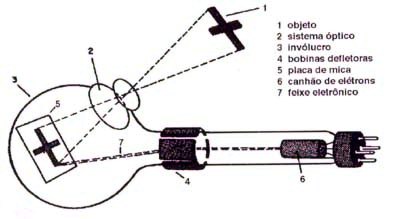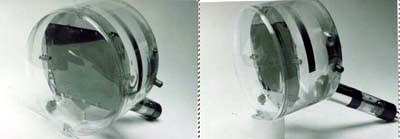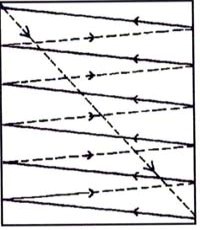For the image generation it was necessary
to develop a similar tube in the transmistter, denominated as
an image converter or camera tube. It was described by the first
time by G. Holst in the later twenties. However, the photo-
cathode camera tubes have been developed from the
 |
| (a) Schematical of the iconoscope, showing
the disposal its structural elements. |
Iconoscope, a Greek word meaning: eikon = image, and skopein
= observation, invented in 1930 by Y.K.Zworykin. Originally,
this was a trade name copyrighted by RCA. (a)
Basically the Iconoscope is an optical electrical device. (b)
In this way, through an optical system the black and white image
is focused on to a mica plate. One side of this plate has a
mosaic of tiny globules of photosensitized material especially
treated for high photoelectric emission. An electron gun and
associated bean deflecting system are mounted in the neck of
the Iconoscope. The electron beam is made to sweep regularly
the mica plate in a zigzag pattern originating the process as
known as scanning. (c) The scanning is started by the flow of
current through the set of horizontal and vertical deflecting
coils and in this way originating the variable raster.
For instance, in the Brazilian television system, there are
625 lines in each picture, which is repeated 25 times per second.
 |
|
(b) Illustration of
the iconoscope originally invented by Vladimir Kosma
Zworykin.
|
Differente quantities of electrons leave the beam in the bright
or dark parts of the image, so varying the current in an electric
circuit connected to the electron gun in sympathy with the variation
in light and shade. Finally, the varying electric current or
signal, from the camera is amplified and modulated by the transmitter.
(d)
Since the invention of the Iconoscope, many were the types of
television cameras launched in the market. Among them are:
- The Emitron, improved in England by J.D.McGee. (f) Even so,
in the photoconductive television camera family other interesting
types are:
- The Vidicon, similar to the Orthicon, but in place of target
plate coated with a photo emissive elements it was replaced
by a thin film made with Antimony Sulphied, which becomes conductive
under the influence of light.
- In the Plumbicon, another type of television camera, where
for the photo emissive layer, it was used a chemically modified
Lead Oxide. (g)
 |
| (d) The Dr. Vladimir Kosma Zworykin
with its invention the iconoscope. Photo archive RCA |
During the WWII, the RCA in the USA, made many researches to
develop a
 |
| (c) Ilustração do processo
de varredura da imagem em ziguezague. |
camera tube for operation at low light intensities for military
applications purpose. The result was the Image Orthicon a, low
inertia, and highly sensitive camera with good definition, circa
100 lux for studios takes.
In this way it became the standard camera tube for black and
white television either for studio as well as for reporting
applications. In 1970, W.S Boyle and G.E. Smith working for
Bell Laboratories, USA, developed a new type of semiconductor
storage device, named CCD or charge-coupled device. (n) As an
electrical optical device, the CCD has a principle basic completely
different when compared with the aforementioned thermionic television
cameras using photosensitize material for the detection of electrons.
In the CCD cameras, the electron detection is made by storing
the charges, which are proportionally absorbed in small wells
or discret elements displayed on a CHIP, known as PIXELS, which
is an acronym for PICTURE ELEMENT.
Nowadays the CCD is used for the manufacturing of the modern
television cameras for home, industrial or scientific applications.
(o) |
|
|